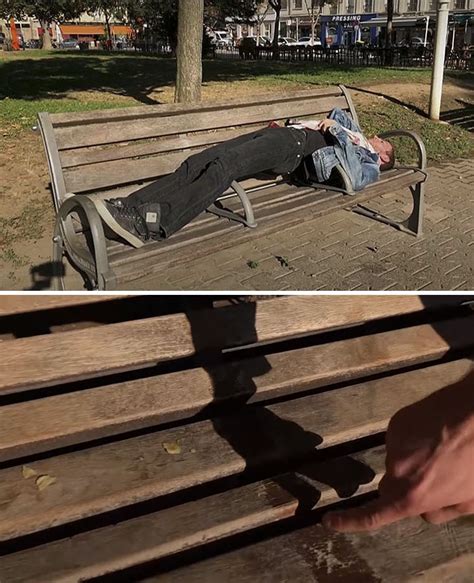
A Los Angeles man’s invention designed to deter homeless individuals from camping near his property has ignited a heated debate, raising questions about the line between property protection and inhumane treatment of a vulnerable population. The device, composed of rotating PVC pipes, aims to prevent people from sleeping or loitering on a specific area, sparking controversy over its ethical implications and potential impact on the city’s ongoing homelessness crisis.
The device, installed by an unidentified Los Angeles resident, features a series of PVC pipes that rotate, preventing individuals from comfortably sitting or lying down. The homeowner claims the device is a humane solution to prevent encampments and maintain cleanliness around his property, which has allegedly been a persistent problem. However, critics argue that it’s a cruel and ineffective measure that further marginalizes the homeless population without addressing the root causes of homelessness. The debate highlights the growing tensions between residents struggling with the effects of homelessness and advocates demanding compassionate and sustainable solutions.
The installation of the rotating pipes has drawn criticism from advocacy groups and individuals who argue that it criminalizes homelessness and punishes people for their lack of housing. Some have labeled the device as “inhumane” and “cruel,” arguing that it forces homeless individuals to move elsewhere without providing any real support or resources. “All it does is push people into other neighborhoods,” said one local advocate, emphasizing the futility of such deterrents.
Proponents of the device, on the other hand, argue that homeowners have a right to protect their property and maintain a safe and clean environment. They claim that the device is a passive deterrent that doesn’t physically harm anyone but effectively discourages encampments, preventing the accumulation of trash, human waste, and other problems associated with homelessness. The homeowner involved stated that the device is a “humane” way to deal with the issue, a sentiment that has been echoed by some community members who feel overwhelmed by the increasing presence of homeless encampments.
The controversy underscores the complex and multifaceted nature of homelessness in Los Angeles, a city grappling with one of the largest homeless populations in the United States. With limited affordable housing options, strained social services, and a growing economic divide, the issue has become a persistent challenge for city officials and residents alike. The debate over the anti-homeless device reflects the deep divisions and frustrations that exist within the community regarding how to address this crisis effectively and compassionately.
The device highlights the growing trend of “hostile architecture,” which involves designing public or private spaces in ways that discourage certain behaviors, such as sleeping or loitering. This trend has been criticized by many as a way to invisibilize social problems rather than solve them. Examples of hostile architecture include benches with armrests that prevent people from lying down, spikes placed in alcoves to deter sleeping, and water sprinklers that activate at certain times to discourage gathering. Critics argue that these measures are ultimately counterproductive, as they simply displace homeless individuals to other areas without addressing their underlying needs.
The city of Los Angeles has been struggling to find effective solutions to address the homelessness crisis. Despite significant investments in affordable housing and supportive services, the number of homeless individuals continues to rise, fueled by factors such as poverty, mental illness, addiction, and a lack of affordable housing. The city has implemented various strategies, including expanding shelter capacity, providing rental subsidies, and offering job training programs. However, these efforts have been hampered by bureaucratic obstacles, community resistance, and a persistent shortage of funding.
The anti-homeless device has sparked a broader discussion about the rights and responsibilities of homeowners, the role of government in addressing homelessness, and the need for more compassionate and sustainable solutions. While some argue that homeowners have a right to protect their property, others contend that this right should not come at the expense of basic human dignity. Advocates for the homeless argue that the city must prioritize investments in affordable housing, mental health services, and other supportive programs that can help people escape homelessness and rebuild their lives.
The incident also raises legal questions about the legality of such devices. While the homeowner claims that the device is legal because it doesn’t physically harm anyone, some legal experts argue that it could be considered a form of harassment or discrimination, violating the rights of homeless individuals. The legality of the device may ultimately depend on local ordinances and court rulings, and the city of Los Angeles may need to clarify its position on the use of such deterrents.
The controversy surrounding the anti-homeless device serves as a microcosm of the larger debate about how to address homelessness in a compassionate and effective manner. It underscores the urgent need for innovative solutions that address the root causes of homelessness, provide support for vulnerable individuals, and foster a sense of community and shared responsibility. The city of Los Angeles, along with other cities facing similar challenges, must find a way to balance the rights of homeowners with the needs of the homeless population, ensuring that everyone has access to safe and affordable housing.
The ethical considerations surrounding the device are significant. Is it ethical to design and implement measures that actively make life more difficult for people already struggling with extreme hardship? Does the right to property outweigh the right to basic human dignity and the need for shelter? These are questions that resonate far beyond the immediate situation in Los Angeles and touch upon broader societal values and responsibilities.
The long-term impact of such devices is also a concern. If more individuals and businesses adopt similar measures, it could lead to a further marginalization and dehumanization of the homeless population, creating a more hostile and divided society. It is crucial that communities engage in open and honest conversations about how to address homelessness in a way that respects the rights and dignity of all individuals, regardless of their housing status.
The situation in Los Angeles reflects a growing trend in many urban areas, where rising housing costs, stagnant wages, and inadequate social safety nets have contributed to a surge in homelessness. The problem is particularly acute in cities with high housing costs, such as Los Angeles, San Francisco, and New York, where even those with jobs may struggle to afford rent. The lack of affordable housing is a major driver of homelessness, and addressing this issue will require a comprehensive and multifaceted approach that includes building more affordable units, increasing rental assistance, and reforming zoning laws.
The role of mental health and addiction in homelessness is also significant. Many homeless individuals suffer from mental illness or substance abuse, which can make it difficult for them to find and maintain housing. Providing access to mental health services, addiction treatment, and supportive housing is essential for helping these individuals escape homelessness and rebuild their lives.
The debate over the anti-homeless device also highlights the importance of public education and awareness. Many people hold negative stereotypes about homeless individuals, viewing them as lazy, dangerous, or unwilling to work. These stereotypes can lead to prejudice and discrimination, making it even more difficult for homeless individuals to find housing and employment. Public education campaigns can help to dispel these myths and promote a more compassionate and understanding attitude towards the homeless population.
The story of the Los Angeles anti-homeless device is not just a local issue; it is a reflection of a broader societal challenge that demands urgent attention and innovative solutions. It is a call for communities to come together and address the root causes of homelessness, providing support for vulnerable individuals and creating a more just and equitable society for all. The response to this crisis will ultimately define our values and shape the future of our communities.
The long-term effects of relying on deterrents such as the rotating PVC pipes could further erode the social fabric of communities. Rather than fostering a sense of collective responsibility and empathy towards vulnerable populations, these measures can contribute to a climate of fear and division. They can also lead to a normalization of inhumane treatment, making it more acceptable to disregard the basic needs and rights of those who are less fortunate.
It is essential that communities explore alternative approaches that are grounded in compassion, respect, and evidence-based practices. These approaches should focus on providing permanent supportive housing, which combines affordable housing with supportive services such as case management, mental health care, and job training. Studies have shown that permanent supportive housing is a cost-effective solution that can help individuals escape homelessness and improve their overall health and well-being.
In addition to permanent supportive housing, communities should also invest in prevention efforts that aim to keep people from becoming homeless in the first place. These efforts can include providing rental assistance to low-income families, expanding access to affordable healthcare, and offering job training programs to help people increase their earning potential. By addressing the root causes of homelessness, communities can create a more stable and equitable society for all.
The role of the media in shaping public perceptions of homelessness is also crucial. Media outlets have a responsibility to report on this issue in a fair, accurate, and nuanced manner, avoiding sensationalism or perpetuation of harmful stereotypes. They should also highlight the stories of homeless individuals, giving them a voice and humanizing their experiences. By providing a more comprehensive and empathetic portrayal of homelessness, the media can help to foster greater understanding and support for solutions.
The legal and regulatory framework surrounding homelessness also needs to be carefully examined. Many cities have laws that criminalize activities such as sleeping in public, loitering, and panhandling. These laws can disproportionately affect homeless individuals, leading to arrests, fines, and jail time. Critics argue that these laws are counterproductive, as they do nothing to address the underlying causes of homelessness and can actually make it more difficult for people to escape homelessness.
Some cities are exploring alternative approaches to these laws, such as decriminalizing homelessness and focusing on providing services and support instead of punishment. These approaches recognize that homelessness is a complex social problem that requires a comprehensive and compassionate response. By shifting away from punitive measures and towards supportive services, communities can create a more humane and effective system for addressing homelessness.
The anti-homeless device in Los Angeles serves as a stark reminder of the challenges and complexities of addressing homelessness in our society. It is a call for us to reflect on our values and consider how we can create a more just and equitable world for all. By embracing compassion, innovation, and evidence-based practices, we can work towards a future where everyone has access to safe, affordable housing and the opportunity to thrive. The conversation sparked by this device must extend beyond simple condemnation or justification. It must lead to action, to policy changes, and to a fundamental shift in how society views and treats its most vulnerable members.
The discussion also needs to address the systemic issues that contribute to homelessness, such as income inequality, lack of access to healthcare, and discrimination in housing and employment. These issues require long-term solutions that involve government, businesses, and community organizations working together to create a more equitable society.
Ultimately, addressing homelessness requires a holistic approach that takes into account the diverse needs of individuals and communities. There is no one-size-fits-all solution, and what works in one city may not work in another. However, by embracing compassion, innovation, and evidence-based practices, we can make progress towards a future where everyone has a place to call home. The Los Angeles case is a microcosm of a much larger problem, and its resolution will require not just local action, but a national commitment to addressing the root causes of homelessness and providing support for those who are most in need. The device may be a temporary fix for one property owner, but it does nothing to solve the underlying crisis and, in fact, exacerbates the problem by pushing it onto someone else’s doorstep. A comprehensive solution requires a commitment to providing affordable housing, mental health services, and job training, as well as addressing the systemic issues that contribute to homelessness in the first place.
The situation also raises questions about the role of technology in addressing social problems. While technology can be a powerful tool for innovation and progress, it can also be used to reinforce existing inequalities and marginalize vulnerable populations. The anti-homeless device is a clear example of how technology can be used to exclude and punish people who are already struggling. It is important to ensure that technology is used in a way that promotes social justice and equity, rather than exacerbating existing inequalities.
The controversy surrounding the device should prompt a deeper examination of the values that underpin our society. Do we prioritize individual property rights over the basic human needs of others? Do we believe that everyone deserves a safe and affordable place to live? These are fundamental questions that must be addressed if we are to create a more just and compassionate society.
The discussion about the anti-homeless device is not just about one particular invention. It is about the broader issue of how we treat people who are less fortunate than ourselves. It is about our responsibility to care for the most vulnerable members of our society. It is about creating a world where everyone has the opportunity to thrive. The device in Los Angeles is a symptom of a much deeper problem, and addressing that problem will require a fundamental shift in our values and priorities.
The device serves as a visual representation of the growing divide between the haves and have-nots in our society. It is a symbol of the increasing inequality and the lack of compassion that characterizes our times. It is a wake-up call that we must do better. We must find ways to bridge the divide and create a more inclusive and equitable society for all. The solution is not to build walls and barriers, but to build bridges and pathways to opportunity.
The installation has become a catalyst for a much-needed conversation about the moral obligations of a community towards its most vulnerable members. It has exposed the raw tensions and frustrations that exist within communities struggling to cope with the visible signs of homelessness. It has forced a confrontation with uncomfortable truths about the inadequacy of existing systems to provide for basic human needs.
The debate around this anti-homeless device, therefore, extends far beyond the physical object itself. It delves into the very heart of our societal values and compels us to ask: What kind of community do we aspire to be? What responsibilities do we have to each other, particularly to those who are struggling? How can we foster a society that is both prosperous and compassionate?
The controversy is a sign that we need to re-evaluate our approach to homelessness. We need to move beyond short-term solutions and focus on long-term strategies that address the root causes of the problem. We need to invest in affordable housing, mental health services, and job training. We need to create a society where everyone has the opportunity to thrive.
The challenge of homelessness is not just a problem for those who are experiencing it. It is a problem for all of us. It affects our communities, our economy, and our social fabric. We all have a stake in finding solutions to this crisis. And we all have a responsibility to do our part.
The story from Los Angeles acts as a reminder that we are all interconnected. The well-being of one person affects the well-being of all. When we fail to care for the most vulnerable members of our society, we are diminishing ourselves. We are creating a world that is less just, less compassionate, and less humane. The time for action is now. We must work together to create a society where everyone has the opportunity to live a life of dignity and purpose.
FAQ:
-
What is the anti-homeless device described in the news article?
- The anti-homeless device is a structure created by a Los Angeles resident, consisting of rotating PVC pipes. Its purpose is to prevent homeless individuals from comfortably sitting or lying down on the area where it is installed, thereby deterring encampments.
-
Why is the device considered controversial?
- The device is controversial because it sparks ethical concerns about the treatment of homeless individuals. Critics argue that it is inhumane and punishes people for being homeless, while proponents argue it’s a legitimate way for property owners to protect their property from encampments and maintain cleanliness.
-
What are the arguments in favor of using such devices?
- Arguments in favor of using such devices include the right of property owners to protect their property, maintain cleanliness, and prevent the accumulation of trash and other problems associated with homeless encampments. Proponents often view the devices as a passive deterrent that doesn’t physically harm anyone.
-
What are the arguments against using such devices?
- Arguments against using such devices include that they are inhumane, cruel, and ineffective. Critics argue that they simply displace homeless individuals without providing any real support or resources, and that they criminalize homelessness and violate basic human rights.
-
What are some alternative solutions to addressing homelessness that are being discussed?
- Alternative solutions discussed include investing in affordable housing, mental health services, addiction treatment, and job training programs. Other approaches include decriminalizing homelessness, providing rental assistance, and implementing prevention efforts to keep people from becoming homeless in the first place. Permanent supportive housing, which combines affordable housing with comprehensive support services, is also frequently mentioned as an effective solution.









